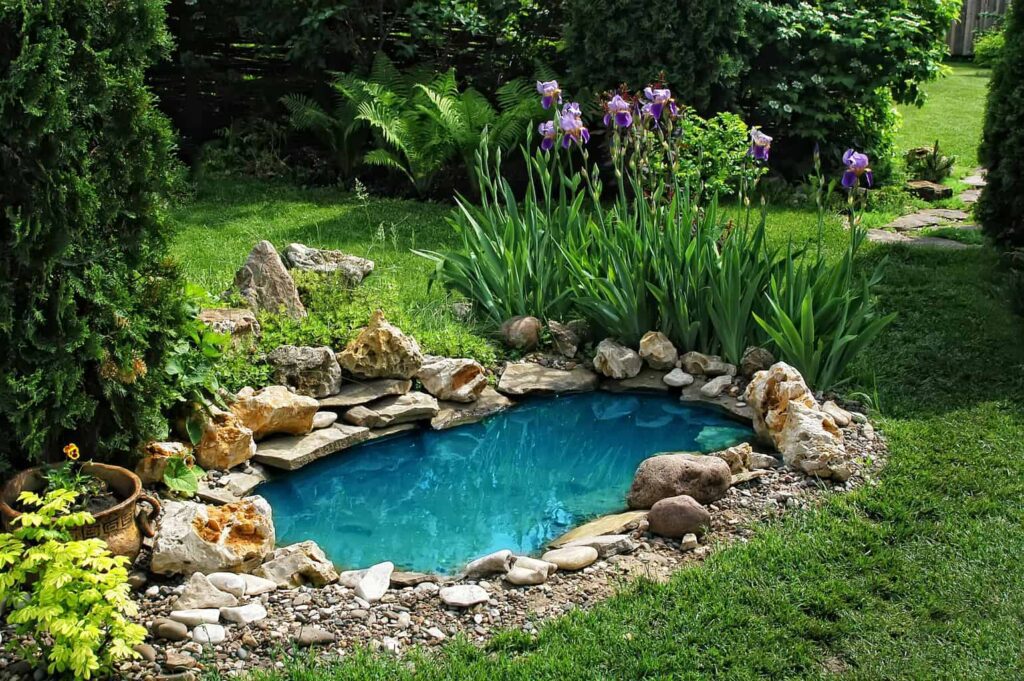Whether you’re a farmer who relies on a pond to house fish and provide water for livestock, or a homeowner who enjoys a pond’s ambiance, pond water loss is a problem. A leaking pond not only causes irrigation issues and landscape damage but also increases water usage, which isn’t ideal for the environment or wallet.
Fortunately, stopping leaks is simpler than you may think. You can use a variety of natural ways to stop the water flow. Keep reading for how to seal a pond naturally using different techniques and materials.
What Causes a Pond to Leak?
You might think a decline in water level is related to evaporation, but if the decrease is significant, it’s likely due to leaking.
You may have a seeping pond for any number of reasons, but some of the most common are poor pond construction, penetrable soils or layers like sand and gravel, and thin soil layers containing cracked bedrock or sinkholes.
Faulty liners, tree growth on dikes, and burrowing animals who dig holes through the pond layers can cause water leakage.

Methods Of Sealing A Pond Naturally: (Cheapest way to Seal A Pond)
Wondering how to seal a pond naturally? Here are some different options using natural methods and materials.
1) Clay Blanket
Ponds built in gravel or rock shelves are acceptable to water leaks, so it’s vital to seal the fractured rock or absorbent material with a packed clay blanket. Create a lining of at least 12 inches thick to properly seal the leak.
Look for soil that has a high clay content (at least 10%). If less clay is used, both in content and thickness, the pond may develop another leak, especially if you plan to drain and dry your pond periodically. Although a necessary task for pond fish farmers, draining the pond can lead to large cracks as the bottom dries, leading to water drainage channels.
If clay is readily available in your area, then this may be the least expensive method of sealing a pond naturally. Check the clay content of any soil you play to use.
2) Levee Repair
If you’re using clay to seal a leak in the pond dike, you can drain the pond down to one or two feet below the leakage site, then dig out the surrounding area until you’re several feet back into the dike. You can then fill the trench with clay and compact it every 8-10 inches as you go.
3) Bentonite
Bentonite, also known as “drillers mud,” is a type of clay formed from weathered volcanic ash. The beauty of bentonite is that it expands when wet, meaning you can apply a layer or blanket of this moist clay to cracks. It will expand 11 to 15 times its original size, successfully plugging the channels between the soil particles and sealing the leak.
To make this impermeable layer, you’ll need to mix the bentonite with sand or soil and water and apply at one to three pounds per square foot. Double the amount if the pond is deep or sitting on porous soil.
There are a few ways to apply bentonite to a leaking pond:
- Drain the pond and spread the bentonite across the pond bottom using a garden spreader or by hand. Then, work the clay mixture into the bottom with a rototiller or disker.
- Mix the bentonite with water to form a slurry and spread over the pond surface from a boat.
- Spread a granular form of bentonite directly over the water. The granules will sink, and the force of the leaking water will draw the bentonite to the sites and seal them.
- Remove four to six inches of soil from the pond bottom and smooth with a roller. Then, apply a blanket layer of bentonite at a rate of one to two pounds per square foot. Create a compacted layer by pressing down the ground; it helps prevent animals from puncturing the seal.
4) Gleization
Gleization is the act of using gley, a material produced by mixing fresh livestock manure with grass, leaves, or straw.
Spread a six to nine-inch layer of the mixture over the leakage site, then cover it with cardboard, plastic, or a protective layer of soil to activate a biochemical reaction between the gley and soil. The fermentation will create a bacterial slime that will act as a soil sealant.
After two weeks, remove the protective cover (if using plastic, cardboard, or something other than organic material) and refill the pond.
5) Livestock
A traditional method of how to seal a pond naturally is by using hogs or cattle to fertilize and pack down the manure, resulting in a pond sealant similar to gley.
This technique requires you to keep your livestock fenced into the pond area for several months. As the pigs or cattle create manure, they also work the waste into the soil as they walk around and trample the surface.
If cattle or pigs are readily available, the livestock method may be the least expensive way to naturally seal a pond. However, it’s important to make sure the pond seals entirely before use. If the basin isn’t completely sealed before water is put back in, the manure and soil mixture can cause nutrient pollution in the surface or groundwater.
Conclusion
A leaking pond can be a frustrating and expensive experience. It’s always best to build a pond on proper soil and use the correct construction techniques. Clay is the most common way to seal a pond naturally, but bentonite, gley, and livestock have also proven successful methods.
The best technique for you will depend on the severity of the leak and the costs involved. Inspect the pond carefully before deciding on which method to use. The Natural Resources Conservation Service can also provide guidance.
Don’t let a small leak turn into a big problem. Use the techniques above to keep your pond in great shape all year long!






